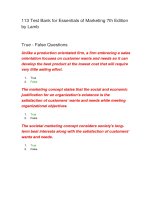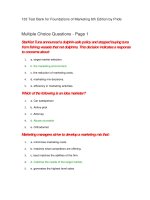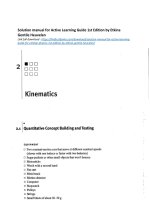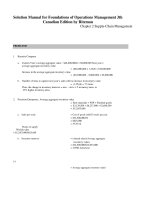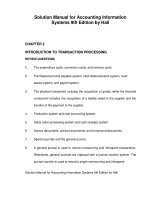Solution manual for foundations of finance 7th edition by keown
Bạn đang xem bản rút gọn của tài liệu. Xem và tải ngay bản đầy đủ của tài liệu tại đây (109.99 KB, 11 trang )
buy this full document at
CHAPTER 1
An Introduction to the Foundations
of Financial Management
CHAPTER ORIENTATION
This chapter lays a foundation for what will follow. First, it focuses on the goal of the firm,
followed by a review of the legal forms of business organization, and a discussion of the tax
implications relating to financial decisions. Ten Principles that form the foundations of
financial management then follow.
CHAPTER OUTLINE
I.
II.
Goal of the firm
A.
In this book, we will designate maximization of shareholder wealth, by which
we mean maximization of the total market value of the firm’s common stock,
to be the goal of the firm. To understand this goal and its inclusive nature, it is
first necessary to understand the difficulties involved with the frequently
suggested goal of profit maximization.
B.
We have chosen the goal of shareholder wealth maximization because the
effects of all financial decisions are included in this goal.
C.
In order to employ this goal, we need not consider every price change to be a
market interpretation of the worth of our decisions. What we do focus on is
the effect that our decision should have on the stock price if everything were
held constant.
Five Principles that Form the Foundations of Finance
A.
Principle 1: Cash Flow Is What Matters. In measuring value we will use
cash flows rather than accounting profits because it is only cash flows that the
firm receives and is able to reinvest. In addition, in making business decisions,
we will concern ourselves with only what happens as a result of that decision.
B.
Principle 2: Money Has a Time Value. Almost all financial decisions involve
comparing money in different time periods, perhaps investing today and
receiving returns later, or borrowing money today and paying it off later. A
dollar received today is worth more than a dollar received in the future
because of the time value of money.
buy this full document at
2 ♦ Keown/Martin/Petty Instructor’s Manual with Solutions
C.
Principle 3: Risk Requires a Reward. There is a risk-return tradeoff in
finance—we won’t take additional risk unless we expect to be compensated
with additional return. Almost all financial decisions involve some sort of riskreturn tradeoff.
D.
Principle 4: Market Prices Are Generally Right. In general, the markets are
quick to impound new information into stock prices, and the prices tend to be
correct.
E.
Principle 5: Conflicts of Interest Cause Agency Problems. As a result of the
agency problem, managers will not work for the owners’ best interest unless it
is in the managers’ best interest as well. The agency problem is a result of the
separation of the decision makers and the owners of the firm. As a result,
managers may make decisions that are not in line with the goal of
maximization of shareholder wealth.
Avoiding Financial Crisis—Back to the Principles. Many of the financial
problems of the past can be traced back to ignoring the basic principles of
finance.
F.
G.
III.
The Role of Finance in Business
A.
finance.
IV.
The Essential Elements of Ethics and Trust. Ethical behavior is doing the
right thing, and ethical dilemmas are everywhere in finance. Ethical behavior
is important in financial management, just as it is important in everything we
do. Unfortunately, precisely how we define what is and is not ethical behavior
is sometimes difficult. Nevertheless, we should not give up the quest. In
addition, businesses cannot interact unless they trust each other.
There are three basic types of issues that are addressed by the study of
1.
What long-term investments should the firm undertake? This area of
finance is generally referred to as capital budgeting.
2.
How should the firm raise money to fund these investments? The firm’s
funding choices are generally referred to as capital structure decisions.
3.
How can the firm best manage its cash flows as they arise in its day-today operations? This area of finance is generally referred to as working
capital management.
The Legal Forms of Business Organization
A.
The significance of different legal forms
1.
B.
The predominant form of business organization in the United States in
pure numbers is the sole proprietorship.
Sole proprietorship: A business owned by a single person and which has a
minimum amount of legal structure.
1.
Advantages
a.
Easily established with few complications
b.
Minimal organizational costs
©2011 Pearson Education, Inc. Publishing as Prentice Hall
Full file at />c.
2.
C.
Does not have to share profits or control with others
Disadvantages
a.
Unlimited liability for the owner
b.
Owner must absorb all losses
c.
Equity capital limited to the owner’s personal investment
d.
Business terminates immediately upon owner’s death
Partnership: An association of two or more individuals coming together as
co-owners to operate a business for profit.
1.
Two types of partnerships
a.
General partnership: Relationship between partners is dictated
by the partnership agreement.
(l)
(2)
b.
Advantages
(a)
Minimal organizational requirements
(b)
Negligible government regulations
Disadvantages
(a)
All partners have unlimited liability
(b)
Difficult to raise large amounts of capital
(c)
Partnership dissolved by the death or withdrawal
of general partner
Limited partnership
(l)
(2)
Advantages
(a)
For the limited partners, liability limited to the
amount of capital invested in the company
(b)
Withdrawal or death of a limited partner does not
affect continuity of the business
(c)
Stronger inducement in raising capital
Disadvantages
(a)
There must be at least one general partner who
has unlimited liability in the partnership
(b)
Names of limited partners may not appear in the
name of the firm
(c)
Limited partners may not participate in the
management of the business
(d)
More expensive to organize than general
partnership, as a written agreement is mandatory
©2011 Pearson Education, Inc. Publishing as Prentice Hall
4 ♦ Keown/Martin/Petty Instructor’s Manual with Solutions
D.
The corporation: An “impersonal”legal entity having the power to purchase,
sell, and own assets and to incur liabilities while existing separately and apart
from its owners.
1.
Ownership is evidenced by shares of stock.
2.
Advantages
3.
4.
a.
Limited liability of owners
b.
Ease of transferability of ownership (i.e., by the sale of one’s
shares of stock)
c.
The death of an owner does not result in the discontinuance of
the firm’s life
d.
Ability to raise large amounts of capital is increased
Disadvantages
a.
Most difficult and expensive form of business to establish
b.
Control of corporation not guaranteed by partial ownership of
stock
c.
Corporations also suffer from a double taxation on dividends.
The firm first pays taxes on the income it earns; after taxes
have been paid on this income, it is paid to investors in the form
of dividends. The investor then pays personal taxes on that
dividend income.
S-Type Corporations and Limited Liability Companies (LLC)
a.
The S-type corporation provides limited liability while allowing
the business owners to be taxed as if they were a partnership—
that is, distributions back to the owners are not taxed twice as
is the case with dividends in the corporate form.
b.
The limited liability company (LLC) is a cross between a
partnership and a corporation. The LLC retains limited liability
for its owners, but is run and taxed like a partnership.
ANSWERS TO
END-OF-CHAPTER QUESTIONS
1-1.
The goal of profit maximization is too simplistic in that it assumes away the problems
of uncertainty of returns and the timing of returns. Rather than use this goal, we have
chosen maximization of shareholders’ wealth—that is, maximization of the market
value of the firm’s common stock—because the effects of all financial decisions are
included. The shareholders react to poor investment or dividend decisions by causing
the total value of the firm’s stock to fall and react to good decisions by pushing the
©2011 Pearson Education, Inc. Publishing as Prentice Hall
Full file at />
1-2.
1-3.
1-4
1-5.
1-6.
price of the stock upward. In this way, all financial decisions are evaluated, and all
financial decisions affect shareholder wealth.
The goal of shareholder wealth maximization must be looked at as a long-run goal. As
such, the public image of the firm may be of concern inasmuch as it may affect sales
and legislation. Thus, while these actions may not directly result in increased profits,
they may affect consumers’ and legislators’ attitudes.
Almost all financial decisions involve some sort of risk-return tradeoff. The more risk
the firm is willing to accept, the higher the expected return for the given course of
action. For example, in the area of working capital management, the less inventory
held, the higher the expected return, but also the greater the risk of running out of
inventory. While one manager might accept a given level of risk, another more riskaverse manager may not accept that level of risk. This does not mean that one
manager is correct and one is not; rather, it only means that not all managers will
view the risk-return tradeoff in the same manner.
The agency problem is a result of the separation of owners and managers, where
managers do what’s in their own best interests rather than what is in the best interest
of the shareholders. Large firms are typically run by professional managers who own
a small fraction of the firms’ equity. The individual actions of these managers are
often motivated by self-interest, which may result in managers not acting in the best
interests of the firm’s owners. When this happens the firm’s owners will lose value.
a.
A sole proprietorship is a business owned by a single individual who maintains
complete title to the assets, and is also personally liable for all indebtedness
incurred.
b.
A partnership is an association of two or more individuals coming together as
co-owners for the purpose of operating a business for profits. The partnership
is equivalent to the sole proprietorship, except that the partnership has
multiple owners.
c.
A corporation is a legal entity functioning separate and apart from its owners.
It can individually sue and be sued, purchase, sell, or own property, and be
subject to criminal punishment for crimes.
a.
The sole proprietor maintains title to the firm’s assets, has unlimited liability,
is entitled to the profits from the business, but must also absorb any losses
realized. This form of business is easily initiated. Termination of the business
comes by the owner discontinuing the business or upon his death.
b.
In a partnership, all general partners have unlimited liability. Each partner is
liable for the actions of the other partners. The partnership agreement dictates
the basic relationships among the partners within the firm. As with the sole
proprietorship, the partnership is terminated upon the desires of any partner
within the organization, or upon a partner’s death. Under certain conditions a
partner’s liability may be restricted to the amount of capital invested in the
partnership. However, at least one general partner must remain in the
association for whom the privilege of limited liability does not apply.
c.
The corporation is legally separate from its owners. Ownership of the
corporation is determined by the number of shares of common stock owned by
an individual. Since the shares are transferable, the ownership in a corporation
may be easily transferred. Investors’ liability is limited to the amount of their
©2011 Pearson Education, Inc. Publishing as Prentice Hall
6 ♦ Keown/Martin/Petty Instructor’s Manual with Solutions
investment. The life of the corporation is not dependent upon the status of the
investors. The death or withdrawal of an investor does not disrupt the
corporate life. However, the cost of forming a corporation is more expensive
than a proprietorship or partnership.
1-7. a.
Organizational requirements and costs favor the sole proprietorship or possibly
the general partnership depending upon the approach taken in forming the
partnership.
b.
Under corporation, owners have minimum liabilities.
c.
The corporation is definitely the most favorable form of business because it
provides the continuity of the business regardless of an owner’s withdrawal or
death.
d.
If ease of ownership transferability is desired, the corporation is best.
However, because of certain circumstances, the owners may prefer that
ownership not be easily transferred, in which case the partnership would be
the most desirable.
e.
The sole proprietor is able to maintain complete and ultimate control and
minimize regulations.
f.
The corporation is the strongest form of legal entity in terms of the ease of
raising capital from external investors.
g.
In regard to income taxes, it is difficult to determine which form of business is
the most advantageous. Such a selection is dependent upon individual
circumstances.
1-8. This is an internet question.
1-9. This is an internet question.
1-10. This is an internet question.
SOLUTION TO MINI CASE
a.
The goal of profit maximization is too simplistic in that it assumes away the problems
of uncertainty of returns and the timing of returns. Rather than use this goal, we have
chosen maximization of shareholders’ wealth—that is, maximization of the market
value of the firm’s common stock—because the effects of all financial decisions are
included. The shareholders react to poor investment or dividend decisions by causing
the total value of the firm’s stock to fall and react to good decisions by pushing the
price of the stock upward. In this way, all financial decisions are evaluated, and all
financial decisions affect shareholder wealth.
b.
Simply put, investors will not put their money in risky investments unless they are
compensated for taking on that additional risk. In effect, the return investors expect is
composed of two parts. First, they receive a return for delaying consumption, which
must be greater than the anticipated rate of inflation. Second, they receive a return for
taking on added risk. Otherwise, both risky and safe investments would have the same
expected return associated with them, and no one would take on the risky
investments.
©2011 Pearson Education, Inc. Publishing as Prentice Hall
Full file at />c.
The firm receives cash flows and is able to reinvest them, which cannot be done with
accounting profits. In effect, accounting profits are shown when they are earned
rather than when the money is actually in hand. Unfortunately, a firm’s accounting
profits and cash flows may not be timed to occur together. For example, capital
expenses, such as the purchase of a new plant or piece of equipment, are depreciated
over several years, with the annual depreciation subtracted from profits. However, the
cash flow associated with these expenses generally occurs immediately. It is the cash
inflows that can be reinvested and cash outflows that involve paying out money.
Therefore, cash flows correctly reflect the true timing of the benefits and costs.
d.
In an efficient market, information is impounded into security prices with such speed
that there are no opportunities for investors to profit from publicly available
information. Actually, what types of information are immediately reflected in security
prices and how quickly that information is reflected determine how efficient the
market actually is. The implications for us are that stock prices reflect all publicly
available information regarding the value of the company. This means we can
implement our goal of maximization of shareholder wealth by focusing on the effect
each decision should have on the stock price, all else held constant. It also means that
earnings manipulations through accounting changes should not result in price
changes. In effect, our preoccupation with cash flows is validated.
e.
The agency problem is the result of the separation of management and the ownership
of the firm. As a result, managers may make decisions that are not in line with the
goal of maximization of shareholder wealth. To control this problem, we monitor
managers and try to align the interests of shareholders and managers. The interests of
shareholders and managers can be aligned by setting up stock options, bonuses, and
perquisites that are tied directly to how closely management decisions coincide with
the interest of shareholders.
f.
Ethical errors are not forgiven in the business world. Business interaction is based
upon trust, and there is no way that trust can be eliminated quicker than through an
ethical violation. The fall of Ivan Boesky and Drexel, Burnham, Lanbert and the near
collapse of Salomon Brothers illustrates this fact. As a result, acting in an ethical
manner is not only morally correct, but it is congruent with our goal of maximization
of shareholder wealth.
g.
(1)
A sole proprietorship is a business owned by a single individual who maintains
complete title to the assets, but who is also personally liable for all
indebtedness incurred.
(2)
A partnership is an association of two or more individuals coming together as
co-owners for the purpose of operating a business for profit. The partnership is
equivalent to the sole proprietorship, except that the partnership has multiple
owners.
(3)
A corporation is a legal entity functioning separate and apart from its owners.
It can individually sue and be sued, purchase, sell, or own property, and be
subject to criminal punishment for crimes.
©2011 Pearson Education, Inc. Publishing as Prentice Hall
8 ♦ Keown/Martin/Petty Instructor’s Manual with Solutions
CASE PROBLEM
LIVING AND DYING WITH ASBESTOS:
WHAT HAPPENS WHEN YOU FIND YOUR MOST PROFITABLE PRODUCT IS
DANGEROUS—AN ETHICAL DILEMMA FOR THE FINANCIAL MANAGER
Much of what we deal with in financial management centers around the evaluation of
projects—when they should be accepted and when they should be terminated. As new
information surfaces regarding the future profitability of a project, the firm always has the
choice of terminating that project. When this new information raises the question of whether
or not it is ethical to produce a profitable project, the decision becomes more difficult. Many
times ethical dilemmas pit profits versus ethics. These decisions become even more difficult
when continuing to produce the product is within the law.
Asbestos is a fibrous mineral used for fireproofing, electrical insulation, building materials,
brake linings, and chemical filters. If one is exposed long enough to asbestos particles—
usually ten or more years—one can develop a chronic lung inflammation called asbestosis,
which makes breathing difficult and infection easy. Also linked to asbestos exposure is
mesethelioma, a cancer of the chest lining. This disease sometimes does not develop until 40
years after the first exposure. Although the first major scientific conference on the dangers of
asbestos was not held until 1964, the asbestos industry knew of the dangers of asbestos 60
years ago.
As early as 1932, the British documented the occupational hazards of asbestos dust
inhalation. Indeed, on September 25, 1935, the editors of the trade journal Asbestos wrote to
Sumner Simpson, president of Raybestos-Manhattan, a leading asbestos company, asking
permission to publish an article on the dangers of asbestos. Simpson refused and later praised
the magazine for not printing the article. In a letter to Vandivar Brown, secretary of JohnsManville, another asbestos manufacturer, Simpson observed: “The less said about asbestos
the better off we are.” Brown agreed, adding that any article on asbestosis should reflect
American, not English, data.
1
In fact, American data were available, and Brown, as one of the editors of the journal, knew
it. Working on behalf of Raybestos-Manhattan and Johns-Manville and their insurance
carrier, Metropolitan Life Insurance Company, Anthony Lanza had conducted research
between 1929 and 1931 on 126 workers with three or more years of asbestos exposure. But
Brown and others were not pleased with the paper Lanza submitted to them for editorial
review. Lanza, said Brown, had failed to portray asbestosis as milder than silicosis, a lung
disease caused by long-term inhalation of silica dust that results in chronic shortness of
breath. Under the then-pending Workmen’s Compensation law, silicosis was categorized as a
compensable disease. If asbestosis was worse than silicosis or indistinguishable from it, then
it too would have to be covered. Apparently Brown did not want this and thus requested that
Lanza depict asbestosis as less serious than silicosis. Lanza complied and also omitted from
his published report the fact that more than half the workers examined—67 of 126—were
suffering from asbestosis.
See Samuel S. Epstein, “The Asbestos Pentagon Papers,” in Mark Green and Robert Massie, Jr., eds.,
The Big Business Reader: Essays on Corporate America (New York: Pilgrim Press, 1980), pp. 154–65.
This article is the primary source of the facts and quotations reported here.
1
©2011 Pearson Education, Inc. Publishing as Prentice Hall
Full file at />Meanwhile, Sumner Simpson was writing F. H. Schulter, president of Thermoid Rubber
Company, to suggest that several manufacturers sponsor further asbestos experiments. The
sponsors, said Simpson, could exercise oversight prerogatives; they “could determine from
time to time after the findings are made whether they wish any publication or not.” Added
Simpson: “It would be a good idea to distribute the information to the medical fraternity,
providing it is of the right type and would not injure our companies.” Lest there should be
any question about the arbiter of publication, Brown wrote to officials at the laboratory
conducting the tests:
It is our further understanding that the results obtained will be considered the
property of those who are advancing the required funds, who will determine
whether, to what extent, and in what manner they shall be made public. In the
event it is deemed desirable that the results be made public, the manuscript of
your study will be submitted to us for approval prior to publication.
Industry officials were concerned with more than controlling information flow. They also
sought to deny workers early evidence of their asbestosis. Dr. Kenneth Smith, medical
director of a Johns-Manville plant in Canada, explained why seven workers he found to have
asbestosis should not be informed of their disease:
It must be remembered that although these men have the X-ray evidence of
asbestosis, they are working today and definitely are not disabled from
asbestosis. They have not been told of this diagnosis, for it is felt that as long as
the man feels well, is happy at home and at work, and his physical condition
remains good, nothing should be said. When he becomes disabled and sick, then
the diagnosis should be made and the claim submitted by the company. The
fibrosis of this disease is irreversible and permanent so that eventually
compensation will be paid to each of these men. But as long as the man is not
disabled, it is felt that he should not be told of his condition so that he can live
and work in peace and the company can benefit by his many years of experience.
Should the man be told of his condition today, there is a very definite possibility
that he would become mentally and physically ill, simply through the knowledge
that he has asbestosis.
When lawsuits filed by asbestos workers who had developed cancer reached the industry in
the 1950s, Dr. Smith suggested that the industry retain the Industrial Health Foundation to
conduct a cancer study that would, in effect, squelch the asbestos-cancer connection. The
asbestos companies refused, claiming that such a study would only bring further unfavorable
publicity to the industry and that there was not enough evidence linking asbestos and cancer
industry-wide to warrant it.
Shortly before his death in 1977, Dr. Smith was asked whether he had ever recommended to
Johns-Manville officials that warning labels be placed on insulation products containing
asbestos. He provided the following testimony:
The reasons why the caution labels were not implemented immediately, it was a
business decision as far as I could understand. Here was a recommendation, the
corporation is in business to make, to provide jobs for people and make money
for stockholders and they had to take into consideration the effects of everything
they did, and if the application of a caution label identifying a product as
hazardous would cut out sales, there would be serious financial implications.
©2011 Pearson Education, Inc. Publishing as Prentice Hall
10 ♦ Keown/Martin/Petty Instructor’s Manual with Solutions
And the powers that be had to make some effort to judge the necessity of the
label vs. the consequences of placing the label on the product.
Dr. Smith’s testimony and related documents have figured prominently in hundreds of
asbestos-related lawsuits, totaling more than $1 billion. In March 1981, a settlement was
reached in nine separate lawsuits brought by 680 New Jersey asbestos workers at a
Raybestos-Manhattan plant. Several asbestos manufacturers, as well as Metropolitan Life
Insurance, were named as defendants. Under the terms of the settlement, the workers affected
will share in a $9.4 million court-administered compensation fund. Each worker will be paid
compensation according to the length of exposure to asbestos and the severity of the disease
contracted.
By 1982, an average of 500 new asbestos cases were being filed each month against Manville
(as Johns-Manville was now called), and the company was losing more than half the cases
that went to trial. In ten separate cases, juries had also awarded punitive damages, averaging
$616,000 a case. By August, 20,000 claims had been filed against the company, and Manville
filed for bankruptcy in federal court. This action froze the lawsuits in their place and forced
asbestos victims to stand in line with other Manville creditors. After more than three years of
legal haggling, Manville’s reorganization plan was finally approved by the bankruptcy court.
The agreement set up a trust fund valued at approximately $2.5 billion to pay Manville’s
asbestos claimants. To fund the trust, shareholders were required to surrender half the value
of their stock, and the company had to give up much of its projected earnings over the next
25 years.
2
Claims, however, soon overwhelmed the trust, which ran out of money in 1990. With many
victims still waiting for payment, Federal Judge Jack B. Weinstein ordered the trust to
restructure its payments and renegotiate Manville’s contributions to the fund. As a result, the
most seriously ill victims will now be paid first, but average payments to victims have been
lowered significantly—from $145,000 to $43,000. Meanwhile, the trust’s stake in Manville
has been increased to 80%, and Manville has been required to pay $300 million to it in
additional dividends.
3
Adapted by permission: William Shaw and Vincent Barry, Moral Issues in Business, 7th
ed., pp. 224-227. Copyright 1995 by Wadsworth, Inc.
QUESTIONS
1.
Should the asbestos companies be held morally responsible in the sense of being
capable of making a moral decision about the ill effects of asbestos exposure? Or does
it make sense to consider only the principal people involved as morally responsible,
for example, Simpson and Brown?
2.
Simpson and Brown presumably acted in what they thought were the best profit
interests of their companies. Nothing they did was illegal. On what grounds, if any,
are their actions open to criticism?
See Robert Mokhiber, Corporate Crime and Violence (San Francisco: Sierra Club Books, 1988), pp. 285–86;
and Arthur Sharplin, "Manville Lives On as Victims Continue to Die," Business and Society Review 65 (Spring
1988), 27–8.
3
“Asbestos Claims to Be Reduced Under New Plan,” Wall Street Journal, November 20, 1990, p. A4; and
“MacNeil-Lehrer Newshour.” December 18, 1990.
2
©2011 Pearson Education, Inc. Publishing as Prentice Hall
Full file at />3.
Suppose that Simpson and Brown reasoned this way: “While it may be in our firms’
short-term interests to suppress data about the ill effects of asbestos exposure, in the
long run it may ruin our companies. We could be sued for millions, and the reputation
of the entire industry could be destroyed. So we should reveal the true results of the
asbestos-exposure research and let the chips fall where they may.” Would that be
appropriate?
4.
If you were a stockholder in Raybestos-Manhattan or Johns-Manville, would you
approve of Simpson and Brown’s conduct? If not, why not?
5.
“Hands of government” proponents would say that it is the responsibility of
government, not the asbestos industry, to ensure health and safety with respect to
asbestos. In the absence of appropriate government regulations, asbestos
manufacturers have no responsibility other than to operate efficiently. Do you agree?
6.
Does Dr. Smith’s explanation for concealing from workers the nature of their health
problems illustrate how adherence to industry and corporate goals can militate against
individual moral behavior? Or do you think Dr. Smith did all he was morally obliged
to do as an employee of an asbestos firm? What about Lanza’s suppression of data in
his report?
7.
It has been shown that spouses of asbestos workers can develop lung damage and
cancer simply by breathing the fibers carried home on work clothes and that people
living near asbestos plants experience higher rates of cancer than the general
population does. Would it be possible to assign responsibility for these effects to
individual members of asbestos companies? Should the companies themselves be held
responsible?
SOLUTION TO CASE
LIVING AND DYING WITH ASBESTOS
With ethics cases, there are no right or wrong answers—just opinions. Try to bring out as
many opinions as possible without being judgmental or allowing other students to be
judgmental. Also, it is effective to try to see if the students feel there are any possible
parallels between what has happened in this case and the tobacco industry.
©2011 Pearson Education, Inc. Publishing as Prentice Hall
